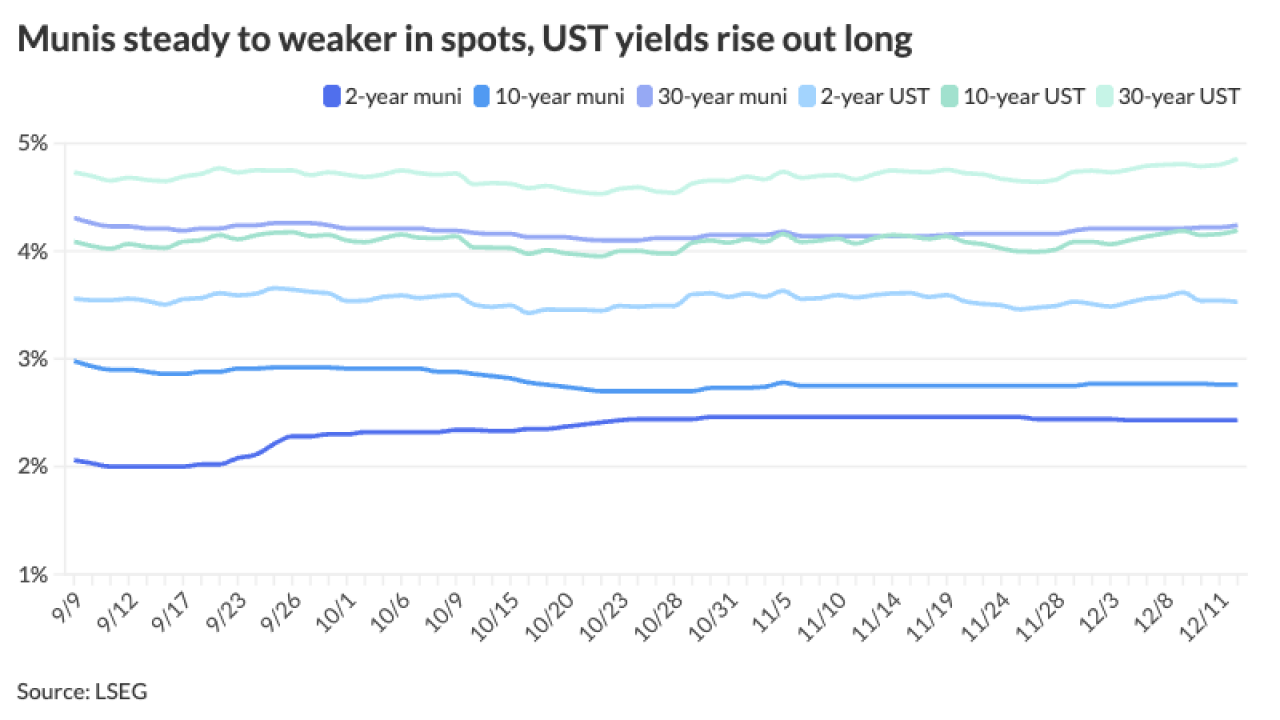
CHICAGO — The Indiana Finance Authority is set to bring at least $250 million of state appropriation-backed private activity bonds to market next week to finance the Hoosier State's newest public-private transportation project.
The authority will loan the proceeds to a private firm that will design, build and operate a 21-mile stretch of Interstate 69.
The highway is a central thoroughfare for southwest Indiana, connecting Evansville to Indianapolis, and officials say it will be key to the state's future economy.
I-69 will eventually extend from Mexico to Canada, "making Indiana an essential part of the primary north-south artery that moves goods and services across the United States," according to Indiana transportation officials.
The fifth stage and subject of next week's financing will upgrade the 21 miles between Bloomington and Martinsville, and will include four new interchanges and four new overpasses.
The deal marks Indiana's second public-private partnership structured with availability payments. The success of the first, last year's Ohio River Bridges project, paved the way for this second financing, state officials said.
Indiana considers itself a leader in the P3 space, a reputation launched by former Gov. Mitch Daniels when he leased the Indiana Toll Road in 2006. The state has since crafted a handful of other high-profile privatizations. In addition to the Ohio River Bridges and now the I-69 project, Indiana is structuring a P3 to finance its half of a new 47-mile toll road to Illinois dubbed the Illiana Expressway.
The bonds are expected to price July 9.
Barnes & Thornburg LLP is bond counsel. Citi and Jefferies are the underwriters.
Standard & Poor's rates the bonds BBB-minus, one notch above junk grade. Fitch Ratings rates the debt BBB.
Rating analysts note a variety of risks attached to the project, ranging from long-term operating risks and construction cost overruns to the appropriation risk common to appropriation-backed bonds. Preliminary bond documents feature 19 pages of risk factors investors should consider.
The IFA has the authority to sell up to $400 million of PABs for the project, which carries a price tag of around $375 million, according to the state. Funds will also include a $40 million equity contribution from the developer and an $80 million milestone payment from the state.
The bonds are not an obligation of Indiana — which does not issue general obligation bonds — and do not feature a full faith and credit pledge.
But for investors, the role of triple-A rated Indiana as a counterparty on the deal should bring comfort, said Indiana Finance Authority director Kendra York. The deal also shifts risk to the private team, providing some protection to the state, she said.
"We chose this structure because it reduces the state of Indiana's risks greatly, transferring the long-term risk of the project to the private contractor," York wrote in an email to The Bond Buyer.
"The agreement structure also includes a guaranteed maximum construction cost, which transfers the risk of cost over runs and construction delays to the private contractor," she said. "We also believe that the availability payment to the contractor is appealing to investors because they are secured by an appropriation from the state. That's something investors would find comforting in the context of risk and reward."
The IFA will issue the bonds and lend the proceeds to the private contractor, I-69 Development Partners LLC. The company is ultimately owned by Isolux Infrastructure Netherlands BV and Infra-PSP Canada Inc., a subsidiary of Public Sector Pension Board Investments, one of Canada's largest pension investment managers.
The issue features several tranches, including a small chunk of serial bonds maturing in 2017 and roughly $246 million of term bonds that mature from 2025 through 2046.
As with the Ohio River Bridges bond deal, the IFA will make milestone payments to the developer during the construction phase and availability payments over the life of the 37-year debt.
Standard & Poor's notes that the concession agreement has "standard provisions" for various events, including delays, compensation events, storms, defaults, disputes, and changes in law.
"We have a view that this concession agreement is a reasonable one and has reasonable performance requirements," S&P analyst Jodi Hecht said during a webinar the ratings firm hosted on the project.
The authority — which is the state's borrowing arm — has inked a separate agreement with the Indiana Department of Transportation.
While there are considerable construction risks, the complexity of the work is not one of them, according to Standard & Poor's, which considers it one of the simplest P3s it has rated in the U.S.
"We analyze construction risk and assess the complexity of the construction itself," analyst Anne Selting said in a telephone interview.
"This is a very simple construction project in our view — it's a road that's on a flat area with few geographical challenges," she said. "The Ohio River Bridges project, which included a tunnel, was much more complex."
The state's top-notch rating brings strengths to the project, analysts said. "We have a very high rating on the state of Indiana, and that was a factor here as a counterparty risk, but I do know that there are operating risks beyond just the availability payments from the state," S&P analyst Henry Henderson said during the webinar.
Fitch Ratings said it analyzed risk relating to IFA's obligations under the agreement and "has determined that the credit quality of IFA's payment stream does not constrain the project debt rating."
Operating risks include requirements that the developer meet certain criteria in the concession agreement, noted S&P's Hecht.
"We've looked at the project and we do think it's got the expertise as well as the funding to adequately perform, but when we look at this project we think there are other risks," said Hecht.
"There are long-term operating risks; for example, this is a road, and some of the availability payments are fixed ... but some costs may not match that," she said, citing the cost of asphalt or paving as examples. "When you start to stress some of those factors there is not a lot of excess cushion for them to fund, and unlike a straight appropriation bond they can't go back to the state and ask them to increase their availability payments to cover their costs."
The IFA's availability payments will be the primary source of revenue to make debt payments during most of the life of the bonds, according to bond documents. The payments are relatively fixed, with 20% of each annual payment indexed to the Consumer Price Index and the remaining 80% indexed to an annual 2.5% growth rate. The state can make deductions to the payments for underperformance.
Bond documents also note that the payments may not match the costs, which could endanger debt payments.
The transportation department will include the full milestone and availability payments as part of its two-year appropriation requests to the General Assembly. INDOT will then make the payments to the IFA, which will make the payments to the private developer.
The deal requires a debt service reserve account to be funded with enough money to cover debt payments due in the next six months.
Fitch figures the average debt service coverage ratio to be 1.54 times, although coverage will be closer to 1.22 times for a long period of time.
Standard & Poor's estimates coverage to average 1.36 times based on its own tests. Like Fitch, S&P notes that coverage will run closer to 1.2 times for most of the life of the debt until the last five to seven years, when it will rise.





